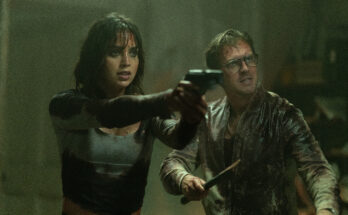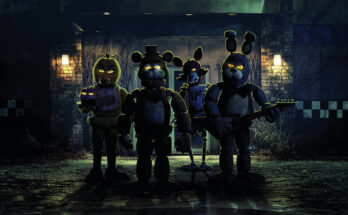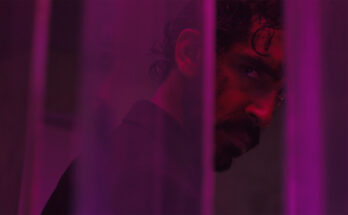Want to hear more from the actors and creators of your favorite shows and films? Subscribe to The Cinema Spot on YouTube for all of our upcoming interviews!
Managing editor & film and television critic with a Bachelor's of Arts in English Literature with a Writing Minor from the University of Guam. Currently in graduate school completing a Master's in English Literature.
Jordan Peele has done it again. Get Out may have been one of the best films of 2017, and perhaps one of the top 10 horror films of this decade, but his new follow-up Us increases the tension ten-fold with a story moviegoers has not seen before.
Let’s analyze the genius of the filmmaker’s psychological horror film. Note that there will be spoilers. If you have not seen Us, do so now and return to this article.

Story Analysis
The film starts off with a statement about abandoned tunnel systems that have lost their use. We then see a young Adelaide Thomas watching a commercial on television about “Hands Across America,” an actual event that occurred in 1986. Throughout Us, we see people from the tunnels called the Tethered who are shadows of those who live on the surface. The role of these people is implied to be a “monkey see, monkey do” type of situation, as Adelaide confirms when she says, “they think like us.” The Tethered’s goal in this film is to kill their surface counterparts and join hands across America (literally) when this is accomplished. When you see this film a second time, you see that Adelaide (married with the surname Wilson) is trying to avoid encountering this.
Us uses the repetition of symbols and phrases:
- A lighthouse is seen on the “Hands Across America” commercial, and again on a painting in Adelaide’s cabin. Lighthouses are used to signal a warning or to foresee trouble ahead of time.
- “11:11” is shown, most notably at the beginning when we see a young homeless man with a sign that reads “Jeremiah 11:11,” which is: “Therefore thus saith the Lord, Behold, I will bring evil upon them, which they shall not be able to escape; and though they shall cry unto me, I will not hearken unto them.” Peele uses this verse from the Bible to foreshadow the Tethered’s goal of taking over the surface by escaping the tunnels. This number is also shown later through the alarm clock in Jason’s bedroom at the cabin before the Wilsons’ Tethered doppelgangers arrive.
- The repeating Black Flag brand and its symbol “IIII” has yet to be interpreted, but perhaps it is to convey that a lot of families are in groups of four, as is with the Wilsons and the Tylers.
- When young Adelaide wanders through the Hall of Mirrors in the attraction, she whistles the tune to the song “Itsy Bitsy Spider,” and her Tethered counterpart Red whistles back in a creepy manner. We later see a spider figure and an actual spider on a table when the Wilsons arrive at their cabin. This could be indicative of the difference between the Tethered and the surface-dwellers, and it especially gives some sense to what Red says at the climax of the film. The spider crawling on the table has a soul, while the spider figure does not.
- Jason uses a toy ambulance to keep the cabin’s closet door from locking him in. Towards the end of the film, we see that the family leaves Santa Cruz in an ambulance. The vehicle represents the only way to get out from the inside. There is no internal or external help except for this.
- When Jason is in the closet with Pluto, we see some board games in the background: Candy Land and Guess Who. Perhaps this is overthinking it, but this adds to the film’s underlying themes of delusion and identity.
- The escalator connecting the Tethered’s tunnel to the surface is indicative of the bridge between Heaven and Hell.

In the 1986 portion of the film, the amusement park attraction that tells patrons to “find yourself” is called “Vision Quest” and features a Native American on its sign, however, the present-day version of the attraction has a medieval wizard and is now called “Merlin’s Forest.” It seems as if to show that history wants to go backward in time.
We get some irony at some points. For example, Zora says “nobody cares about the end of the world” long before her family’s tunnel copies arrive at the cabin. Sure enough, we learn that the Tethered have started an uprising, bringing about an apocalypse of the surface-dwellers.
In addition to the Wilsons’ Tethered copies is that of the Tyler family. Tim Heidecker’s Tex proves to be a great villain than he is a somewhat “good” guy as Josh Tyler, but more so with Elisabeth Moss’s Dahlia as opposed to her surface counterpart Kitty Tyler. The use of the characters’ twin daughters is remarkable as well and is a horrific homage to the Grady twins from Kubrick’s The Shining.
The film also pays hilarious homage to the 1990 John Hughes film Home Alone. When Gabe and Adelaide argue whether they should just stay in the Tyler home and ward off the Tethered until the Untethering event is over, Gabe suggests setting up traps. This is a reference that is not appreciated enough, as is the case when Zora asks, “What’s Home Alone?”

Each member of the Wilson family are “tested by God” when they are divided and left to deal with their Tethered doppelgangers with only their skill:
- Gabe Wilson has his glasses taken away and is deprived of sight. He has only his strength when fighting Abraham.
- Zora is chased after her doppelganger Umbrae in a test of speed.
- Jason has a test of cunning, including his ability to create fire with his counterpart Pluto. (His mother tells him, “Show [Pluto] one of your tricks.”)
- Adelaide and Red have been struggling throughout the film with having to escape from their restraints. They both exhibit flexibility that they have learned through ballet.
The former two of the above tests of skill have been referenced in Jordan Peele’s prior film, Get Out, wherein African American individuals are captured and their agility and strength are exploited for the white man’s use. Another good allusion to Peele’s other film involves Jason eating a bowl of cereal without milk in the Tylers’ home after having killed their Tethered copies, but that could just be overlooking things. In Get Out, we see Rose sitting on her bed eating cereal from a bowl and sipping a glass of milk through a straw, rather than eating cereal with milk in the bowl like a normal person.

One of the best elements of the film is its twist ending. When the Tethered first arrive at the Wilson family’s cabin, Red tells the story of how she and Adelaide met:
“Once upon a time, there was a girl, and the girl had a shadow. The two were connected.”
Red speaks about the differences between the Tethered and the surface-dwellers. Those on the surface live a life of luxury that including warm meals and having beautiful families, while the Tethered live in the tunnels surviving off scraps, eating raw rabbits, and birthed monsters. The Tethered are near-perfect duplicates of their surface counterparts, although Red says that they are each a “copy of the body, but not the soul.” During a first watch of the film, audiences are rooting for the good guy, whom they believe is Adelaide from the surface, but at the end, we discover her to be Red, who had switched places with the actual Adelaide on the surface when they were children. A second viewing of Us gives more sense to the fact that Adelaide knew there would be trouble upon returning to Santa Cruz, and we find evidence that foreshadows the twist throughout the film:
- “Red” (the real Adelaide) is the only Tethered from the tunnels who can actually articulate words and full sentences, while the rest can only make feral noises.
- “Adelaide” (the real Red) urges her husband not to take her family to the beach in Santa Cruz, where they could find the actual Adelaide, but when they do go there, she emphasizes that Jason does not leave her sight because he could wander off into the “Find Yourself” attraction.
- When Zora kills her doppelganger Umbrae, “Adelaide” goes off into the woods to find the body. She calms down a laughing Umbrae by shushing her, indicative of pseudo-Adelaide’s ability to communicate with the Tethered, having once been raised amongst them in the tunnels.
- In the tunnels, “Red” tries to sneak up on “Adelaide” but is pierced by her choice of weapon: the cabin’s fire poker. “Red” tries to whistle, but “Adelaide” uses her chain restraints to strangle and kill “Red,” then lets out a feral scream, an attribute that all the Tethered have. The real Red, also known as “Adelaide,” can do this.
- In flashbacks during the entirety of the film, we see that a young Adelaide does not speak to her parents after the events that occurred with her in the tunnel. What audiences do not learn until the final scene of the film is that the real Adelaide had been held captive in the tunnels, while Red took her place on the surface.
Upon first viewing of the film, I had thought that the film is a representation of colonization when the real Adelaide (as “Red”) says, “We’re Americans,” but after lengthy rumination and another viewing, we can now say that the film represents the lower class’s uprising against the upper class. “Red” speaks about humans on the surface that get to “grow up with the sky” and take their natural resources for granted. In regards to the tunnel systems, she says that the “humans built this place.” Peele uses this line to tell viewers that the upper class is a major factor impacting the lower class and the areas inhabited by this group. One could add that Peele has thrown in some assimilation. After going through the “Vision Quest” attraction, Red and Adelaide learn to live in a new culture, or rather a new way of life. The attraction is renamed “Merlin’s Forest,” implying a medieval tone in which both women try to claim their right to power.
Red’s monologues throughout Us conveys Peele’s excellent screenwriting skills. In the climax, she says:
“God brought us together that night. The miracle happened; that’s when I saw God. The Tethered saw that I was different. It took years to plan [to] make a statement for the whole world to see.”
The Wilsons, their family dynamics, and their roles in the film are just played out so well that you would definitely want to see Us again. Winston Duke’s Gabe plays the role of the father with “dad jokes,” from the obsolete dabbing to his Home Alone fight-or-flight state of mind. Shahadi Wright Joseph and Evan Alex play the roles of Zora/Umbrae and Jason/Pluto ever so wonderfully, but most of all, Lupita Nyong’o steals the show with her performance as Adelaide Wilson and Red through her delivery of lines and executing Red’s voice, in which Nyong’o says to have mimicked a condition called spasmodic dysphonia.
Lupita Nyong'o on crafting her creepy #UsMovie voice (Watch) https://t.co/wXyJ3taDIL pic.twitter.com/nqCKqh9Tlm
— Variety (@Variety) March 23, 2019
I feel that Adelaide and Red’s stories could have been fleshed out a little more in terms of background information, but perhaps that might be asking for too much. Jordan Peele takes a typical story of two completely different people (I would suppose Mark Twain’s The Prince and the Pauper) and gives it a twisted aspect with horror movie elements. His use of the names (originating from multiple mythologies) is laudable too.

Cinematography and Music
The film is vividly shot in such a way that there is almost no single frame that does not resonate in viewers’ minds. The soundtrack in Us is splendid, too. It features song such as “I Like That” by Janelle Monae, “Good Vibrations” by The Beach Boys, “Fuck Tha Police” by N.W.A., and renditions of Luniz’s “I Got 5 On It.” Michael Abels also deserves credit for the film’s score.
Overall, Us is a great follow-up to Get Out. Fans are hoping for Peele to confirm a connection between the two, even to the point that perhaps they share a universe. Jordan Peele ups the ante with a story that has a type of pacing that is just as intense as the filmmaker’s prior film if not more. He gives us a mind-blowing yet unusual story and a relatable concept, then throws in a song you would not expect to be remixed into an instrumental that has your hearts beating faster than usual. One thing future storytellers can definitely learn from this film is to create something that caters to you rather than to provide audiences something that they themselves could enjoy. In an interview with talk show host Jimmy Fallon, Peele says:
“I knew I could just make a movie that I wanted to see. My favorite movie that doesn’t exist, and that’s what I did” (3:42).
“I can make a movie, say, with like a black family in the center of a horror film, which is like the type of movie that I always wish I had growing up, is to have something in my favorite genre, and unlike Get Out, this one’s not about race. It’s about a lot of things, it’s about duality, … it’s a monster movie, and I just return to this idea that if I make what I want to see, make what I wish somebody would make for me” (4:07 – 4:41).
https://www.youtube.com/watch?v=ayajYIoO15k
For the efforts and dedication put into this film, Us gets a 9.5 out of 10.

What are your thoughts? Do you agree? Is there anything we missed in our analysis of the story? Will you see this movie more than once? Do you have five on it? Let us know! Jordan Peele’s Us is in theaters today. For more Jordan Peele and horror-related news and reviews, follow The Cinema Spot on Twitter (@TheCinemaSpot) and Instagram (@thecinemaspot_).
Managing editor & film and television critic with a Bachelor's of Arts in English Literature with a Writing Minor from the University of Guam. Currently in graduate school completing a Master's in English Literature.




